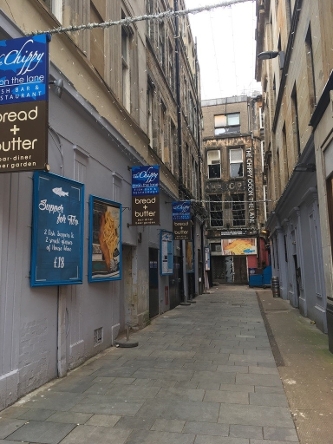- Glasgow City Council
- > News Archive
- > Archive News 2018
- > January 2018
- > Council considers final version of strategy for Glasgow's city centre lanes
Council considers final version of strategy for Glasgow's city centre lanes

Glasgow City Council today (30 January) considered the final version of a strategy that aims to make the best use of the 90 lanes in the city centre.
The council's Neighbourhoods, Housing and Public Realm Committee also considered findings from a public consultation on the draft City Centre Lane Strategy.
This lanes strategy, as part of the council's wider city centre strategy, views the city centre's lane network as a valuable part of Glasgow's rich heritage and character.
Some of the key findings of the public consultation included:
- Over 90% of respondents used the lanes within the city centre;
- Over 90% of the respondents were members of the public;
- The vast majority of respondents agreed with the strategic interventions proposed. The highest level of agreement was for the interventions relating to arts and culture at 89%;
- 88% of the respondents felt that a Lane Activation Fund would have a positive impact on the development of lanes and their increased use;
- There was also considerable focus on the need to address the provision for waste/recycling and public health and community safety. These scored 75% and 84% respectively;
- Support for the development of new initiatives was tempered by the perceived need to resolve cleanliness and safety issues first;
- There was significant support for the proposed changes to planning guidance (84%) and consensus that this would improve the lanes (88%);
- Over 70% of respondents agreed with the draft Strategy's Implementation Plan. This rose to 92% when respondents who selected the "neither/nor" option are included.
Some city centre lanes have always enjoyed a variety of uses, and in recent years have been joined by a number of others which have been transformed into successful public spaces with independent shops, restaurants and bars contributing to Glasgow's day and night-time economies.
However, many other lanes in the city centre do not have such activity and can be locations where anti-social behaviour takes place, as well as a being a poor physical environment with unauthorised parking and excessive refuse disposal systems.
The draft City Centre Lane Strategy was drafted in consultation with stakeholders including local residents and businesses, Glasgow Chamber of Commerce, community groups, charities, local transport bodies, waste contractors, landowners, artists and artisans to consider how best to regenerate the lanes network.
The strategy examined the uses - historic and current - of each lane, taking into account their individual characteristics and considering the impact of planning policies on the network. In addition, the experience of cities from around the world who have developed similar lane strategies, such as Montreal, San Francisco, Seattle and Melbourne, has also been taken into account in the development of the Glasgow strategy.
The strategy also proposes a range of potential actions, such as events and pop-up activities; integration with the new public realm to be delivered through the city centre 'Avenues' programme; the management of future development aided by planning policy and design guidance to ensure the optimal regeneration of lanes where possible; and initiatives on waste and recycling; public health and community safety; and parking and surfacing.
After a review of the results of the consultation, the action plan for the delivery of the strategy has been further developed in the following areas:
- The emphasis on changes to waste management and public safety is strengthened and with the city centre-wide roll-out of the commercial waste project, this will include monitoring and enforcement of publicly accessible lanes to ensure compliance;
- Links will be developed where possible with the wider commercial sector such as advertising, marketing and property agents, to ensure the optimisation of benefits;
- The potential of the lanes to be an asset used by the creative industries will be strengthened by integrating them into existing city-wide networks. Discussions with Glasgow Life and Creative Scotland have already started to map shared ambitions;
- Given the strength of responses with regards to the planning guidance section, the development of related proposals will be given greater priority, particularly those in relation to active frontages and spaces, waste/recycling, maintenance and security, public access, and built heritage;
- The Action Projects will be progressed in line with the strategy's recommendations. The initial period will focus on developing each lane's project plan in collaboration with local lane stakeholders;
- The Strategic Interventions will also be progressed in line with the strategy's recommendations. Eight thematic areas each present either challenge or opportunity for the city centre lanes. A proposal will be developed for each thematic area, and this may cover one or more lanes.
Councillor Kenny McLean, City Convener for Neighbourhoods, Housing and Public Realm at Glasgow City Council said: "While many of our city centre lanes thrive, others could find far more productive uses. So this is an important step in the regeneration of our lanes, a key asset for the city, and runs alongside our plans for the development of the entire city centre."
Glasgow City Centre Lane Strategy document can be found here.





